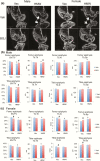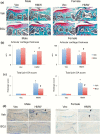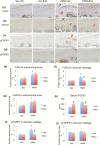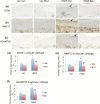Inhibition of FGFR Signaling Partially Rescues Osteoarthritis in Mice Overexpressing High Molecular Weight FGF2 Isoforms
- PMID: 31901095
- PMCID: PMC6959088
- DOI: 10.1210/endocr/bqz016
Inhibition of FGFR Signaling Partially Rescues Osteoarthritis in Mice Overexpressing High Molecular Weight FGF2 Isoforms
Abstract
Fibroblast growth factor 2 (FGF2) and fibroblast growth factor receptors (FGFRs) are key regulatory factors in osteoarthritis (OA). HMWTg mice overexpress the high molecular weight FGF2 isoforms (HMWFGF2) in osteoblast lineage and phenocopy both Hyp mice (which overexpress the HMWFGF2 isoforms in osteoblasts and osteocytes) and humans with X-linked hypophosphatemia (XLH). We previously reported that, similar to Hyp mice and XLH subjects who develop OA, HMWTg mice also develop an OA phenotype associated with increased degradative enzymes and increased FGFR1 compared with VectorTg mice. Therefore, in this study, we examined whether in vivo treatment with the FGFR tyrosine kinase inhibitor NVP-BGJ398 (BGJ) would modulate development of the OA phenotype in knee joints of HMWTg mice. VectorTg and HMWTg mice (21 days of age) were treated with vehicle or BGJ for 13 weeks. Micro-computed tomography images revealed irregular shape and thinning of the subchondral bone with decreased trabecular number and thickness within the epiphyses of vehicle-treated HMWTg knees, which was partially rescued following BGJ treatment. Articular cartilage thickness was decreased in vehicle-treated HMWTg mice, and was restored to the cartilage thickness of VectorTg mice in the BGJ-treated HMWTg group. Increased OA degradative enzymes present in HMWTg vehicle-treated joints decreased after BGJ treatment. OA in HMWTg mice was associated with increased Wnt signaling that was rescued by BGJ treatment. This study demonstrates that overexpression of the HMWFGF2 isoforms in preosteoblasts results in osteoarthropathy that can be partially rescued by FGFR inhibitor via reduction in activated Wnt signaling.
Keywords: FGF receptor inhibitor; FGF2 HMWTg mice; cartilage; osteoarthritis.
© Published by Oxford University Press on behalf of the Endocrine Society 2020.
Figures








Similar articles
-
Inhibition of FGFR Signaling Partially Rescues Hypophosphatemic Rickets in HMWFGF2 Tg Male Mice.Endocrinology. 2017 Oct 1;158(10):3629-3646. doi: 10.1210/en.2016-1617. Endocrinology. 2017. PMID: 28938491 Free PMC article.
-
FGF2 High Molecular Weight Isoforms Contribute to Osteoarthropathy in Male Mice.Endocrinology. 2016 Dec;157(12):4602-4614. doi: 10.1210/en.2016-1548. Epub 2016 Oct 12. Endocrinology. 2016. PMID: 27732085 Free PMC article.
-
FGF receptor inhibitor BGJ398 partially rescues osteoarthritis-like phenotype in older high molecular weight FGF2 transgenic mice via multiple mechanisms.Sci Rep. 2022 Sep 24;12(1):15968. doi: 10.1038/s41598-022-20269-6. Sci Rep. 2022. PMID: 36153352 Free PMC article.
-
FGF and FGFR signaling in chondrodysplasias and craniosynostosis.J Cell Biochem. 2005 Dec 1;96(5):888-96. doi: 10.1002/jcb.20582. J Cell Biochem. 2005. PMID: 16149058 Review.
-
High molecular weight FGF2: the biology of a nuclear growth factor.Cell Mol Life Sci. 2009 Jan;66(2):225-35. doi: 10.1007/s00018-008-8440-4. Cell Mol Life Sci. 2009. PMID: 18850066 Free PMC article. Review.
Cited by
-
Fibroblast growth factor receptor 1-bound extracellular vesicle as novel therapy for osteoarthritis.Biomedicine (Taipei). 2022 Jun 1;12(2):1-9. doi: 10.37796/2211-8039.1308. eCollection 2022. Biomedicine (Taipei). 2022. PMID: 35836973 Free PMC article. Review.
-
Fibroblast Growth Factors and Cellular Communication Network Factors: Intimate Interplay by the Founding Members in Cartilage.Int J Mol Sci. 2022 Aug 2;23(15):8592. doi: 10.3390/ijms23158592. Int J Mol Sci. 2022. PMID: 35955724 Free PMC article. Review.
-
Beta-caryophyllene prevents the defects in trabecular bone caused by Vitamin D deficiency through pathways instated by increased expression of klotho.Bone Joint Res. 2022 Aug;11(8):528-540. doi: 10.1302/2046-3758.118.BJR-2021-0392.R1. Bone Joint Res. 2022. PMID: 35920089 Free PMC article.
-
What Can We Learn from FGF-2 Isoform-Specific Mouse Mutants? Differential Insights into FGF-2 Physiology In Vivo.Int J Mol Sci. 2020 Dec 31;22(1):390. doi: 10.3390/ijms22010390. Int J Mol Sci. 2020. PMID: 33396566 Free PMC article. Review.
-
FGFR families: biological functions and therapeutic interventions in tumors.MedComm (2020). 2023 Sep 23;4(5):e367. doi: 10.1002/mco2.367. eCollection 2023 Oct. MedComm (2020). 2023. PMID: 37750089 Free PMC article. Review.
References
-
- Econs MJ, Francis F. Positional cloning of the PEX gene: new insights into the pathophysiology of X-linked hypophosphatemic rickets. Am J Physiol. 1997;273(4):F489–F498. - PubMed
-
- Hardy DC, Murphy WA, Siegel BA, Reid IR, Whyte MP. X-linked hypophosphatemia in adults: prevalence of skeletal radiographic and scintigraphic features. Radiology. 1989;171(2):403–414. - PubMed
-
- Reid IR, Hardy DC, Murphy WA, Teitelbaum SL, Bergfeld MA, Whyte MP. X-linked hypophosphatemia: a clinical, biochemical, and histopathologic assessment of morbidity in adults. Medicine (Baltimore). 1989;68(6):336–352. - PubMed
-
- Liang G, Vanhouten J, Macica CM. An atypical degenerative osteoarthropathy in Hyp mice is characterized by a loss in the mineralized zone of articular cartilage. Calcif Tissue Int. 2011;89(2):151–162. - PubMed
Publication types
MeSH terms
Substances
Grants and funding
LinkOut - more resources
Full Text Sources
Medical
Research Materials
Miscellaneous

